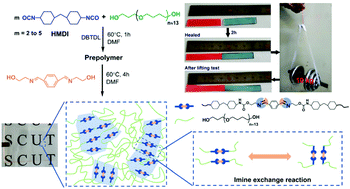A self-healing polyurethane elastomer with excellent mechanical properties based on phase-locked dynamic imine bonds†
Abstract
Self-healing materials with high mechanical strength have attracted much attention, but the facile fabrication of such high-performance materials remains a challenge. In this work, we report a robust self-healing polyurethane elastomer by employing the imine bond, which readily undergoes a dynamic exchange reaction under mild conditions. A symmetric imine-diol chain extender was fabricated through a Schiff base condensation reaction. By tuning the hard segment content, the tensile strength reached up to 40 MPa with elongation at the break of 880%. And in the meantime, it showed an efficient self-healing capability at elevated temperatures, and its mechanical properties were fully recovered (ησ = 96%) after 2 h of healing at 80 °C. The extraordinary balance between the mechanical properties and the self-healing efficiency was due to two reasons. First, the rigid C![[double bond, length as m-dash]](https://www.rsc.org/images/entities/char_e001.gif) N double bond and the symmetric structure of the imine-diol promote microphase separation and facilitate the orientation of chain segments during the strained induced crystallization. Secondly, the dynamic imine exchange reaction is phase-locked in the hard phases. As the temperature is elevated, the self-healing processes are sped up by the accelerated relaxation of hard phases due to the exchange reactions of imine bonds embedded within.
N double bond and the symmetric structure of the imine-diol promote microphase separation and facilitate the orientation of chain segments during the strained induced crystallization. Secondly, the dynamic imine exchange reaction is phase-locked in the hard phases. As the temperature is elevated, the self-healing processes are sped up by the accelerated relaxation of hard phases due to the exchange reactions of imine bonds embedded within.



 Please wait while we load your content...
Please wait while we load your content...